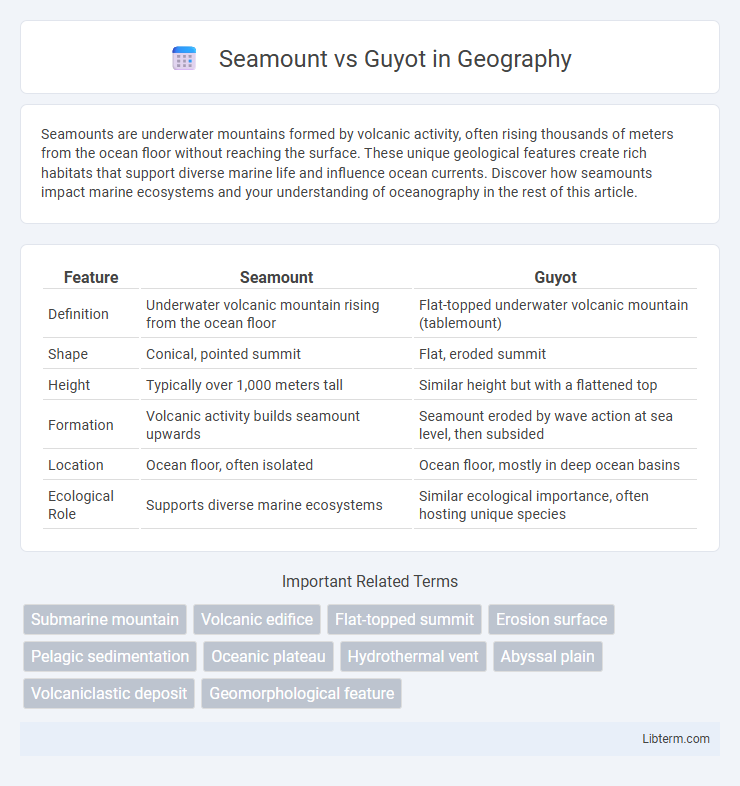Seamounts are underwater mountains formed by volcanic activity, often rising thousands of meters from the ocean floor without reaching the surface. These unique geological features create rich habitats that support diverse marine life and influence ocean currents. Discover how seamounts impact marine ecosystems and your understanding of oceanography in the rest of this article.
Table of Comparison
| Feature | Seamount | Guyot |
|---|---|---|
| Definition | Underwater volcanic mountain rising from the ocean floor | Flat-topped underwater volcanic mountain (tablemount) |
| Shape | Conical, pointed summit | Flat, eroded summit |
| Height | Typically over 1,000 meters tall | Similar height but with a flattened top |
| Formation | Volcanic activity builds seamount upwards | Seamount eroded by wave action at sea level, then subsided |
| Location | Ocean floor, often isolated | Ocean floor, mostly in deep ocean basins |
| Ecological Role | Supports diverse marine ecosystems | Similar ecological importance, often hosting unique species |
Introduction to Seamounts and Guyots
Seamounts are underwater mountains formed by volcanic activity, typically rising sharply from the ocean floor without breaching the surface. Guyots, also known as tablemounts, are seamounts that have flat, eroded tops due to wave action when they were once above sea level. Both features provide critical habitats for marine life and offer insights into geological processes and oceanic plate movements.
Defining Seamounts: Key Characteristics
Seamounts are underwater mountains rising at least 1,000 meters above the seafloor, formed primarily by volcanic activity. Their conical shape distinguishes them, often featuring steep slopes and summit peaks, unlike flat-topped guyots shaped by erosion. Seamounts serve as critical ecological hotspots, supporting diverse marine life through nutrient upwelling and unique habitats.
What is a Guyot? Core Features
A guyot is a flat-topped underwater volcanic mountain, characterized by its submerged summit that was once above sea level but has been eroded by wave action and subsidence. Unlike a seamount, which maintains a conical shape with a pointed peak, a guyot features a leveled, plateau-like top formed through erosion and coral growth before sinking below the ocean surface. These geological structures are primarily found in ocean basins and provide insights into volcanic activity, sea level changes, and tectonic plate movements.
Formation Processes: Seamounts vs Guyots
Seamounts form through volcanic activity as underwater mountains rising from the ocean floor, primarily created by magma eruptions at mid-ocean ridges or hotspots. Guyots originate as seamounts but undergo erosion and subsidence, flattening their tops due to wave action and the gradual sinking of the oceanic crust. The key difference in formation is that guyots are seamounts that have been eroded and planed off beneath sea level, often signifying older volcanic structures.
Morphological Differences: Shape and Structure
Seamounts are underwater mountains with steep, conical shapes formed by volcanic activity, typically rising sharply from the ocean floor. Guyots, also known as tablemounts, are flat-topped seamounts resulting from erosion and subsidence that flatten their peaks near sea level. The primary morphological difference is the seamount's pointed summit versus the guyot's distinctive, flattened top.
Geological Significance of Seamounts and Guyots
Seamounts are underwater volcanic mountains rising sharply from the seafloor, providing critical habitats for marine life and influencing oceanic circulation patterns. Guyots, also known as tablemounts, are flat-topped seamounts formed by wave erosion when they were above sea level, recording geological processes of subsidence and volcanic activity. Both structures contribute to understanding plate tectonics, hotspot volcanism, and the history of ocean basin development.
Ecological Roles in Marine Environments
Seamounts and guyots serve as critical ecological hotspots by providing diverse habitats that support high biodiversity and unique marine species assemblages. Seamounts, with their steep slopes, enhance nutrient upwelling, promoting plankton growth and sustaining rich food webs, while guyots, characterized by flat summits, offer extensive benthic habitats for sessile organisms and fish aggregations. Both structures contribute significantly to marine productivity, acting as stepping stones for species dispersal and refuges for endangered marine life.
Distribution and Locations Worldwide
Seamounts are underwater volcanic mountains found widely across the world's ocean basins, with high concentrations in the Pacific Ocean's Ring of Fire, Atlantic Ocean, and Indian Ocean. Guyots, also known as tablemounts, are seamounts that have flat tops due to erosion and are primarily located in the Pacific Ocean, especially in regions like the Emperor Seamount chain and the Hawaiian-Emperor seamount chain. Both formations contribute to marine biodiversity hotspots and influence oceanic currents and ecosystems globally.
Notable Examples of Seamounts and Guyots
The Emperor Seamounts in the North Pacific Ocean exemplify prominent seamount chains, characterized by their volcanic origins and underwater conical shapes. Notable guyots include the Great Meteor Tablemount in the Atlantic Ocean, distinguished by its flat-topped summit formed through erosion above sea level before subsidence. Both seamounts and guyots serve as critical habitats for marine biodiversity and provide insights into oceanic volcanic activity and plate tectonics.
Seamounts vs Guyots: Summary of Key Differences
Seamounts are underwater mountains rising sharply from the ocean floor, usually with pointed or conical tops, while guyots are flat-topped seamounts formed by erosion or subsidence. Seamounts typically exhibit volcanic origins and significant ecological hotspots, whereas guyots represent older, submerged volcanoes whose summits have been leveled by wave action before sinking below sea level. The primary distinction lies in their summit morphology: seamounts have peaked tops, and guyots possess flattened tops due to prolonged geological processes.
Seamount Infographic

 libterm.com
libterm.com